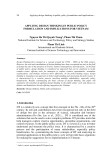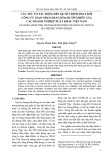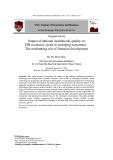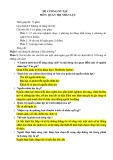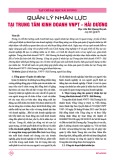
3
HUNG VUONG UNIVERSITY JOURNAL OF SCIENCE AND TECHNOLOGY Vol. 37, No. 4 (2024): 3 - 14
*Email: namnd@thanhdong.edu.vn
TẠP CHÍ KHOA HỌC VÀ CÔNG NGHỆ
TRƯỜNG ĐẠI HỌC HÙNG VƯƠNG
Tập 37, Số 4 (2024): 3 - 14
HUNG VUONG UNIVERSITY
JOURNAL OF SCIENCE AND TECHNOLOGY
Vol. 37, No. 4 (2024): 3 - 14
Email: tapchikhoahoc@hvu.edu.vn Website: www.hvu.edu.vnjst.hvu.vn
FINANCIAL SUSTAINABILITY IN COMMUNITY TOURISM
DEVELOPMENT - AN EMPIRICAL INVESTIGATION
IN THE NORTHWEST REGION OF VIETNAM
Nguyen Danh Nam1*, Uong Thi Ngoc Lan1
1Faculty of Economics and Business Administration, Thanh Dong University, Hai Duong
Received: 13 November 2024; Revised: 27 November 2024; Accepted: 05 December 2024
DOI: https://doi.org/10.59775/1859-3968.223
Abstract
The study aims to identify factors affecting financial sustainability in community tourism development in
the Northwest region. Survey data were collected from 135 tourism business households and individuals
with direct and indirect income from tourism activities in the community tourism village in the Northwest
region. Findings from the structure equation model (SEM) using the AMOSS 20 software indicated that climate
change, holidaymaker market, infrastructure and policy have a positive impact on financial sustainability in
the development of community tourism in the Northwest region. The holidaymaker market has the greatest
impact, followed by climate change, infrastructure, and finally policy. Based on the research results, some
recommendations are proposed to maintain sustainable finance for people/organizations that are directly or
indirectly involved in tourism business activities in the process of community tourism development.
Keywords: Financial sustainability, community tourism, Northwest region.
1. Introduction
The Northwest region of Vietnam consists
of six provinces: Lao Cai, Lai Chau, Yen
Bai, Dien Bien, Son La, and Hoa Binh
with an area of about 50,576 km2, where is
blessed with nature with majestic natural
landscapes along with the unique diversity
of cultures of more 20 ethnic minorities
living in this region, such as H’Mong, Thai,
Muong, Tay and so on. It is one of the crucial
factors for developing types of tourism,
including community tourism. Currently,
the Northwest region has 100 community
tourism destinations contributing to hunger
eradication, poverty reduction, job creation
for local people, and increased community
welfare. Although community tourism
development has achieved some results, the
region still faces many difficulties, such as
a lack of investment capital, monotonous
tourism products, fierce competition between
regions, and so on.

4
HUNG VUONG UNIVERSITY JOURNAL OF SCIENCE AND TECHNOLOGY Nguyen Danh Nam and Uong Thi Ngoc Lan
Community tourism development has
become a vital catalyst for economic growth
in many countries [1]. Nevertheless, the
tourism development process also has many
potential risks affecting the income of local
people [2]. Therefore, understanding the
factors that affect financial sustainability
in the process of tourism development will
support tourism managers in putting forward
specific policies to help maintain financial
sustainability and overcome negative factors
affecting financial sustainability in the
process of community tourism development
in localities.
Community tourism models highlight
positive interaction between holidaymakers,
local communities, and the environment.
This model not only aims to create a
unique tourism experience but also covers
improving the quality of life of local
communities and protecting resources. The
relationship between community tourism and
financial sustainability is expressed through
dimensions such as increasing income for
the community, preserving cultural and
natural values, environmental protection,
sustainable development, and stabilization
of income sources for local communities.
Hence, community tourism not only focuses
on personal experience but also aims to
create sustainable benefits for the community
and the environment, contributing to the
common goal of financial sustainability in
tourism development.
Financial sustainability in tourism ensures
viable processes and long-term economic
activities that bring socio-economic benefits
to stakeholders, which are equitably
distributed, including jobs and opportunities
to earn stable incomes and social services
for local communities and contribute to
poverty alleviation [3]. The issue of financial
sustainability needs a guarantee from the
supply side (the government) and the demand
side (the local community). However, this
study only focuses on sustainability from the
tourism supply side. Moreover, achieving
financial sustainability in the tourism
development process is complicated due to
the interaction of many factors, risks and
objective and subjective factors.
In recent years, there have been many
studies related to financial sustainability, the
previous studies focused on each specific
enterprise [4,6]. Nevertheless, studies on
financial sustainability related to a field are
scant, especially in the field of tourism in
general and community tourism in particular.
This study is the first work on this issue in
the Northwest region, the study aims to
specifically identify the factors that affect
financial sustainability in the development of
community tourism, and the extent of their
impact. As a result, the study put forward
several suggestions to maintain finance
sustainability in the community tourism
development process in localities in the
Northwest region. Our findings can be applied
to other areas with conditions similar to the
Northwest, such as many ethnic minorities,
complex hilly terrain, unique culture and
relatively pristine natural landscapes.
2. Methods
2.1. Theoretical overview and research
hypothesis development
Over the past years, community tourism
has been implemented in many localities as a
sustainable approach to tourism development,
empowering the community economically
and socially while preserving cultural and
environmental resources well [7]. Financial
sustainability in community tourism
development is critical to ensure long-term
viability and benefit local communities [8].
Many studies explored the key factors that
affect financial sustainability in tourism
development, especially community
tourism. Several studies have highlighted

5
HUNG VUONG UNIVERSITY JOURNAL OF SCIENCE AND TECHNOLOGY Vol. 37, No. 4 (2024): 3 - 14
the importance of financial management in
community tourism and sustainable financial
models. For instance, Goeldner and Ritchie
are keen on financial management to ensure
the benefits of both the community and
tourism enterprises [9]. Giampiccoli et al.
proposed a sustainable financial model for
community tourism, focusing on revenue
optimization and cost management [10].
However, previous studies mainly focused
on financial management from the supply
side. There have been very few studies about
factors affecting financial sustainability
from the objective side. More importantly,
no empirical research was conducted in
Vietnam, an emerging economy in Southeast
Asia. Therefore, the authors chose the
analysis in this study. As a result, this research
focuses on macro and objective factors such
as climate change, the holidaymaker market,
infrastructure, the environment, culture and
society, and policy.
2.1.1. Climate change
Climate change is the transformation
from one equilibrium state to another state of
equilibrium of the climate system [11]. The
climate change sign is an increase in average
temperature, rising sea levels, extreme
weather phenomena, and natural disasters
(storms, floods, droughts) occurring with
greater frequency, intensity, and abnormality.
Climate change is becoming a major challenge
to maintaining financial sustainability in
community tourism development. Studies
have proven that climate change can
impact financial management, through
influencing travel patterns and changing the
business environment. For example, climate
fluctuations can lead to changes in tourism
seasons, which in turn affects tourism
demand as well as investment activities
and income of the local tourism community
[12]. Additionally, Buckley also put forward
an in-depth analysis of sustainable tourism
practices, delving into the challenges posed
by climate change and the financial impacts
on businesses and tourism destinations. He
provided insights into strategies for achieving
financial sustainability in a changing climate
[13]. Besides, many other studies focus on
the effect of climate change on financial
sustainability, such as Craig and Feng [14],
Kaján and Saarinen [15], Pang et al. [16]
and so on. Based on the argument above, the
hypothesis is proposed as follows:
H1: Climate change will be positively
associated with financial sustainability
2.1.2. Holidaymaker market
The tourism market is a source market for
holidaymakers, where they go from there to
other places to consume tourism services [17].
The impact of the holidaymaker market is a
crucial facet that determines the stability of
revenue sources and financial sustainability in
the tourism development process. Mukherjee
and Banerjee argues that effective market
access and good implementation of marketing
strategies are essential to ensure the financial
sustainability of community tourism activities
[18]. The results of Agazade et al. suggested
that the holidaymaker market has a significant
impact on the volatility of tourism revenue.
The concentration of the holidaymakers
market is associated with a high volatility level
in tourism revenue, while the diversification
of the holidaymaker market is also associated
with that volatility [19]. Based on the argument
above, the hypothesis is proposed as follows:
H2: Holidaymaker market will be positively
associated with financial sustainability
2.1.3. Infrastructure
Infrastructure is the physical conditions
(houses, roads, means of transport and so
on). In tourism, infrastructure is products of
transportation, roads, systems of restaurants
and hotels, and so on [20]. Infrastructure is
a necessary condition to attract and retain
holidaymakers [21] and it is also one of the
prerequisites for the development of community

6
HUNG VUONG UNIVERSITY JOURNAL OF SCIENCE AND TECHNOLOGY Nguyen Danh Nam and Uong Thi Ngoc Lan
tourism [22]. Ensuring these facilities meet or
exceed holidaymakers’ expectations is critical
to financial sustainability [23]. In addition,
some studies indicated that infrastructure has
a significant impact on revenue and financial
sustainability in the local tourism business,
such as Daniel et al. [24], the United Nations
[25], and so on. Based on the argument above,
the hypothesis is proposed as follows:
H3: Infrastructure will be positively
associated with financial sustainability
2.1.4. Environment
The current state of the tourism environment
encompasses natural conditions, the diversity
and abundance of tourism resources, as well
as the levels of pollution, degradation of the
natural environment, and deterioration of
cultural heritage values. The primary goal
of community tourism development is to
achieve sustainable development, which
includes the protection of natural resources
and the preservation of the local landscape
and environment. Hence, environmental
factors is crucial in attracting and providing
tourism services for tourists, ensuring
financial sustainability for the community.
The success of community tourism models
depends heavily on prioritizing environmental
conservation and implementing sustainable
resource management strategies [27]. The
decline in the quality of natural resources
in community tourism destinations can
have a significant negative impact on their
attractiveness to tourists, thereby seriously
affecting tourism revenues. Therefore, it is
important to prioritize sustainable methods
to effectively protect the environment and
promote responsible tourism [28] [28]. These
approaches not only ensure environmental
conservation but also enhance the long-term
attractiveness and financial sustainability of
community tourism activities. Based on the
argument above, the hypothesis is proposed
as follows:
H4: Environment will be positively
associated with financial sustainability
2.1.5. Culture and society
Culture and society in tourism development
result from the interactions between local
communities and holidaymakers [30]. Doan
argued that cultural impacts pertain to changes
in traditional conceptions and values, local
norms, and identities. Social impacts, on the
other hand, are human impacts that focus
on changes to the quality of life of local
communities caused by community tourism
development [31]. Thence, preserving local
cultural values and traditions is one of the
indispensable aspects of community tourism,
which affects the ability to attract tourism
and financial sustainability in the tourism
development process [32]. Holidaymakers tend
to be attracted to community tourism activities
that offer unique and rich cultural experiences.
However, creating a balance between tourism
development and cultural preservation is still a
challenge [28]. Based on the argument above,
the hypothesis is proposed as follows:
H5: Culture and society will be positively
associated with financial sustainability
2.1.6. Policy
The State and government have
demonstrated their commitment to
community tourism development through
the establishment of legal documents, which
are reflected in the Party’s policies, the
State’s laws on community tourism, and
the provincial views and orientations for
community tourism development. According
to Connelly and Sam, legal frameworks and
State support have a significant impact on
the financial viability of community tourism
programs [33]. The increase in the head and
growth of community tourism activities
is achieved through government policies,
incentives, and legal frameworks that
support the development of the industry. On
the other hand, some inappropriate policies

7
HUNG VUONG UNIVERSITY JOURNAL OF SCIENCE AND TECHNOLOGY Vol. 37, No. 4 (2024): 3 - 14
can be a significant barrier to the tourism
industry’s development [34]. The successful
development of community tourism programs
depends heavily on government programs’
alignment with ideas of sustainability and
community empowerment. According
to Armstrong, community activities in
community tourism development require
mechanisms, incentives for cooperation,
support policies from state management
agencies, and intersectoral linkages to
support, sustain, and develop tourism,
thereby creating sustainable livelihoods [35].
Based on the argument above, the hypothesis
is proposed as follows:
H6: Policy will be positively associated
with financial sustainability
The research model is illustrated in Figure
1 as follows:
2.2. Data research
2.2.1. Scale
To combine theory and scientifically
analyzed data, we combine both qualitative
and quantitative research methods. The
qualitative study was conducted using a
concentrated group interview technique with
10 households participating in community
tourism activities to adjust the scale in
detail. The results of the group interview
were selected to build a questionnaire for
quantitative research.
The results have a total of 26 questions
from 5 studies by Wu et al. [36], Mucharreira
et al. [37], Nguyen [21], Habib et al. [29] and
Aslam et al. [38].
2.2.2. Data collection
To carry out this study, the authors
and the authors surveyed April to August
2024 community tourism destinations of
the Northwest region: Sin Suoi Ho village
(Lai Chau), Nghia Do tourist village (Lao
Cai), Lac and Van village (Hoa Binh), Luoi
village (Son La), To Kho Kho village (Dien
Bien), Khim Noi community tourism cultural
village (Yen Bai). The survey subjects
include tourism business households and
individuals with direct and indirect income
from tourism activities in the study area.
Survey subjects are selected according to
the snowball method and answered online
through a questionnaire set up on a Google
form or invited directly.
The study uses a 5-level Likert scale. With
a total of 26 survey questions, and using a 5:1
ratio, the minimum sample size required was
130 [39]. To improve representativeness, we
increased the sample size, and after verifying
and removing samples with incomplete
answers, we obtained 135 valid responses
with a response rate of 80 per cent, including
60 business households and 75 individuals.
Figure 1. Research model
Source: Recommended authors.




